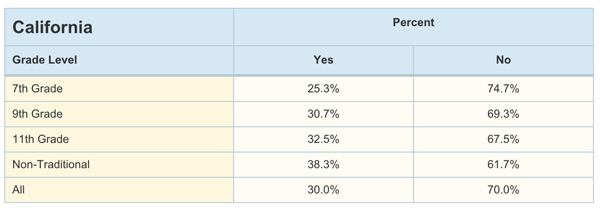Focus on the Figures is a regular partnership between The Imprint and KidsData.org, a nonprofit dedicated to providing data on the health and well-being of California’s children.
For those challenged by mental health conditions, disorders often take hold at the most inopportune times: while adolescents make the difficult climb into adulthood.
A 2005 study by the Harvard Medical School Department of Health Care Policy found that half of lifetime mental health disorders take hold by age 14, and 75 percent take hold by age 24.
When mental health problems challenge children and adolescents to the point of crisis, psychiatric hospitalizations can provide a short dose of safety and stability while professionals work with them on longer-term plans to treat the disorder.
A quick study of the data from California reveals that crisis-level mental health situations result in hospitalizations far more frequently for older teens than for their younger counterparts:

Number of hospitalizations for mental health issues per 1,000 children and youth ages 5-19, by age group.
Data Source: Special tabulation by the State of California, Office of Statewide Health Planning and Development (Sept. 2015); California Dept. of Finance, Race/Ethnic Population with Age and Sex Detail, 2000-2010, 2010-2060 (Sept. 2015).
Footnote: Data are limited to hospital admissions only; emergency room visits that did not result in admission are excluded. A full list of diagnoses included can be found at: http://www.cms.gov/icd10manual/fullcode_cms/P0325.html; this list, and data, excludes disorders related to substance abuse. LNE (Low Number Event) refers to data that have been suppressed because there were fewer than 20 hospitalizations for mental health issues in a given age group. Data are excluded for a relatively small number of cases for patients with erroneous birth dates. Data are also excluded from county totals, but included in state totals, for a relatively small number of cases in which county identification is unknown.
In 2014, California hospitalized 13,710 children between the ages of five and 14 for mental health issues, a rate of 2.7 per 1,000.
Compare that with the 25,827 teenagers between 15 and 19 who were hospitalized in the state for mental health reasons, a rate of 9.7 per 1,000. That’s nearly twice the amount of hospitalizations, at about four times the rate.
The statewide rate of hospitalizations for mental health has ticked up from 1.7 per 1,000 in 2007 to the current rate of 2.7. Among the older teens, the rate has jumped from 6.7 in 2007 to 9.7.
The state’s biggest county, Los Angeles, accounted for 7,200 hospitalizations among 15- to 19-year-olds last year, about 28 percent of all cases. But L.A. is not fueling the recent statewide surge; it comprised the same percentage of California’s 15-19 mental health hospitalizations in 2007.
Meanwhile, several other sizable counties – including Fresno, Merced, Riverside – saw their hospitalizations more than double.
What mental health conditions create such a severe crisis for youth that hospitalization becomes necessary? Nationally, the main driver is an affliction generally not perceived as this severe: depression.
Depression is one of the most common emotional health problems among youth, with an estimated 11 percent of U.S. adolescents diagnosed with depression by age 18, according to the 2015 National Comorbidity Survey. In 2013, 30 percent of high school students nationwide reported persistent feelings of sadness or hopelessness, a very strong indicator of depression.

Percentage of public school students in grades 7, 9, 11, and non-traditional students reporting whether in the past 12 months they had felt so sad or hopeless almost every day for two weeks or more that they stopped doing some usual activities.
Data Source: California Department of Education, California Healthy Kids Survey and California Student Survey (WestEd).
Footnote: The 2011-2013 time period reflects data from school years 2011-12 and 2012-13. District- and county-level figures are weighted proportions from the 2011-13 California Healthy Kids Survey, and state-level figures are weighted proportions from the 2011-13 California Student Survey. The grade levels included in school district data depend on the grades offered in each district; for example, high school districts do not include 7th grade data. “Non-Traditional” students are those enrolled in Community Day Schools or Continuation Education; according to Ed-Data, these schools make up about 10% of all public schools in California. N/A indicates that the survey was not administered in that period or that data are not available for that group. LNE (Low Number Event) indicates that for a specific answer there were fewer than 25 respondents. N/R indicates that the sample is too small to be representative.
A recent study found that depression accounted for 44 percent of all pediatric mental health hospital admissions.
According to the National Comorbidity Survey, youth suffering from depression are more likely to engage in suicidal behavior, drop out of school, use alcohol or drugs, and have unsafe sexual activity, in addition to having difficulties with school and relationships.





